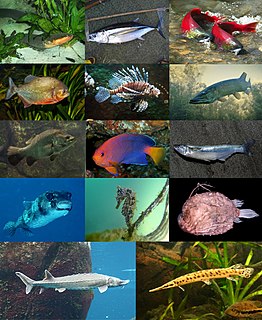
Actinopterygii, members of which are known as ray-finned fishes, is a clade of the bony fishes.
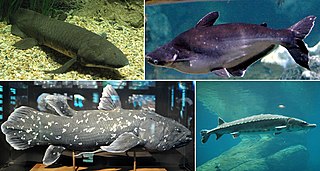
Osteichthyes, popularly referred to as the bony fish, is a diverse taxonomic group of fish that have skeletons primarily composed of bone tissue. They can be contrasted with the Chondrichthyes, which have skeletons primarily composed of cartilage. The vast majority of fish are members of Osteichthyes, which is an extremely diverse and abundant group consisting of 45 orders, and over 435 families and 28,000 species. It is the largest class of vertebrates in existence today. The group Osteichthyes is divided into the ray-finned fish (Actinopterygii) and lobe-finned fish (Sarcopterygii). The oldest known fossils of bony fish are about 420 million years old, which are also transitional fossils, showing a tooth pattern that is in between the tooth rows of sharks and bony fishes.

Fishing is the activity of trying to catch fish. Fish are often caught in the wild but may also be caught from stocked bodies of water. Techniques for catching fish include hand gathering, spearing, netting, angling and trapping. “Fishing” may include catching aquatic animals other than fish, such as molluscs, cephalopods, crustaceans, and echinoderms. The term is not normally applied to catching farmed fish, or to aquatic mammals, such as whales where the term whaling is more appropriate. In addition to being caught to be eaten, fish are caught as recreational pastimes. Fishing tournaments are held, and caught fish are sometimes kept as preserved or living trophies. When bioblitzes occur, fish are typically caught, identified, and then released.

Gnathostomata are the jawed vertebrates. The term derives from Greek: γνάθος "jaw" + στόμα "mouth". Gnathostome diversity comprises roughly 60,000 species, which accounts for 99% of all living vertebrates. In addition to opposing jaws, living gnathostomes have teeth, paired appendages, and a horizontal semicircular canal of the inner ear, along with physiological and cellular anatomical characters such as the myelin sheaths of neurons. Another is an adaptive immune system that uses V(D)J recombination to create antigen recognition sites, rather than using genetic recombination in the variable lymphocyte receptor gene.
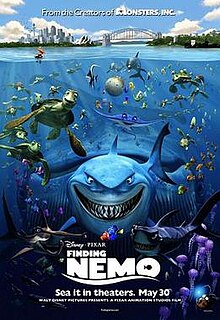
Finding Nemo is a 2003 American computer-animated adventure film produced by Pixar Animation Studios and released by Walt Disney Pictures. Directed and co-written by Andrew Stanton with co-direction by Lee Unkrich, the screenplay was written by Bob Peterson, David Reynolds, and Stanton from a story by Stanton. The film stars the voices of Albert Brooks, Ellen DeGeneres, Alexander Gould, and Willem Dafoe. It tells the story of an overprotective clownfish named Marlin, who, along with a regal blue tang named Dory searches for his missing son Nemo. Along the way, Marlin learns to take risks and comes to terms with Nemo taking care of himself.
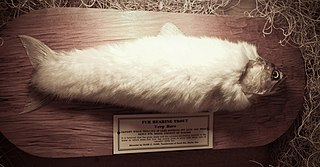
The fur-bearing trout is a legendary creature purportedly found in American folklore and Icelandic folklore. According to folklore, the trout has created a thick coat of fur to maintain its body heat. Tales of furry fish date to the 17th-century and later the "shaggy trout" of Iceland. The earliest known American publication dates from a 1929 Montana Wildlife magazine article by J.H. Hicken. A taxidermy furry trout produced by Ross C. Jobe is a specimen at the Royal Museum of Scotland; it is a trout with white rabbit fur "ingeniously" attached.

The rainbow trout is a trout and species of salmonid native to cold-water tributaries of the Pacific Ocean in Asia and North America. The steelhead is an anadromous (sea-run) form of the coastal rainbow trout(O. m. irideus) or Columbia River redband trout (O. m. gairdneri) that usually returns to fresh water to spawn after living two to three years in the ocean. Freshwater forms that have been introduced into the Great Lakes and migrate into tributaries to spawn are also called steelhead.

Fish are gill-bearing aquatic craniate animals that lack limbs with digits. They form a sister group to the tunicates, together forming the olfactores. Included in this definition are the living hagfish, lampreys, and cartilaginous and bony fish as well as various extinct related groups. Around 99% of living fish species are ray-finned fish, belonging to the class Actinopterygii, with over 95% belonging to the teleost subgrouping.

Big Fish Games is a casual gaming company based in Seattle, with a regional office in Oakland, California, owned by Aristocrat Leisure. It is a developer and distributor of casual games for computers and mobile devices. It has been accused of knowingly deceiving customers into signing up for monthly purchases without informed consent. It was also the subject of a class action lawsuit over its app Big Fish Casino, resulting in a settlement of $155 million after a federal appeals court ruled that it constituted illegal online gambling.
Notoraja is a genus of skates in the family Arhynchobatidae. They are found in deep water in the Indian and western Pacific Ocean.

Robert Anthony Fish is an American professional wrestler. He is currently signed to WWE, where he competes on the NXT brand. He is a member and co-founder of The Undisputed Era.

Pescetarianism is the practice of using seafood as the only source of meat in a diet that is otherwise vegetarian.
Sinibotia is a genus of loaches found in rivers and streams of eastern Asia, specifically southeast China, Laos, Vietnam and east Thailand. There are currently six recognized species in this genus.
Epiplatys sexfasciatus or six-barred panchax is a species of fish in the family Aplocheilidae that can be found in West and Central Africa. The fish is a timid surface dwelling predator. The six-barred panchax is up to 10 cm (4 in) long and closely resembles Epiplatys longiventralis.
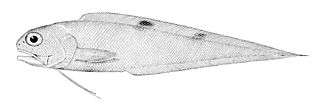
Neobythites is a genus of cusk-eels.
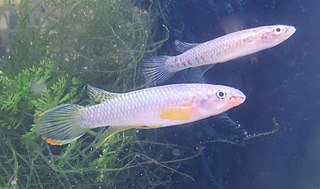
Epiplatys is a genus of African rivuline in the family Nothobranchiidae endemic to Africa as the name indicates. Several of these species are popular aquarium fish.
Parasinilabeo longibarbus is a species of cyprinid fish endemic to China.
Parasinilabeo maculatus is a species of cyprinid fish endemic to China.
Parasinilabeo microps is a species of cyprinid fish endemic to China.












